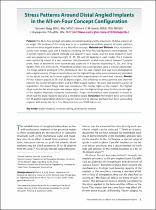Stress patterns around distal angled implants in the all-on-four concept configuration
Abstract
Purpose: The All-on-Four concept advocates immediate loading and the placement of distal implants
at an angle. The purpose of this study was to do a qualitative descriptive analysis of stress patterns
around the distal angled implant of the All-on-Four concept. Materials and Methods: Four photoelastic
acrylic resin models, each with four implants simulating the All-on-Four configuration, were prepared.
The two central implants were placed vertically and parallel in each model, and the distal implant on
each side was placed at an increasing angle (0, 15, 30, and 45 degrees) in each model. The four
implants were splinted by means of a cast metal bar. The photoelastic models were placed between
two parallel anvils. Pairs of abutments were systematically subjected to a load by suspending 5-, 10-,
and 15-kg weights from one of the anvils. Photoelastic analysis was accomplished using a circular
polariscope. The fringe patterns produced in the photoelastic resin for each implant and load were
photographed with a digital camera. Fringe concentrations and the highest fringe order were recorded
and described for the apical, central, and coronal regions of the distal angled implant for each load
scenario. Results: For the implants placed at 15- and 30-degree angles, little difference in stress patterns
was observed between the central straight implant and the distal angled implant. For every load
scenario and for all angulations, the lowest fringe order was recorded at the central region of the
implant. The highest fringe order for the apical region was always higher than the highest fringe order
for the coronal region of the implant. Markedly increased isochromatic fringe concentrations were
observed in model 4, which had the distal implants placed at a 45-degree angle. Conclusion: Periimplant
bone surrounding the 45-degree-angled distal abutment may be more prone to occlusal overload
than bone surrounding implants with lesser tilts.

